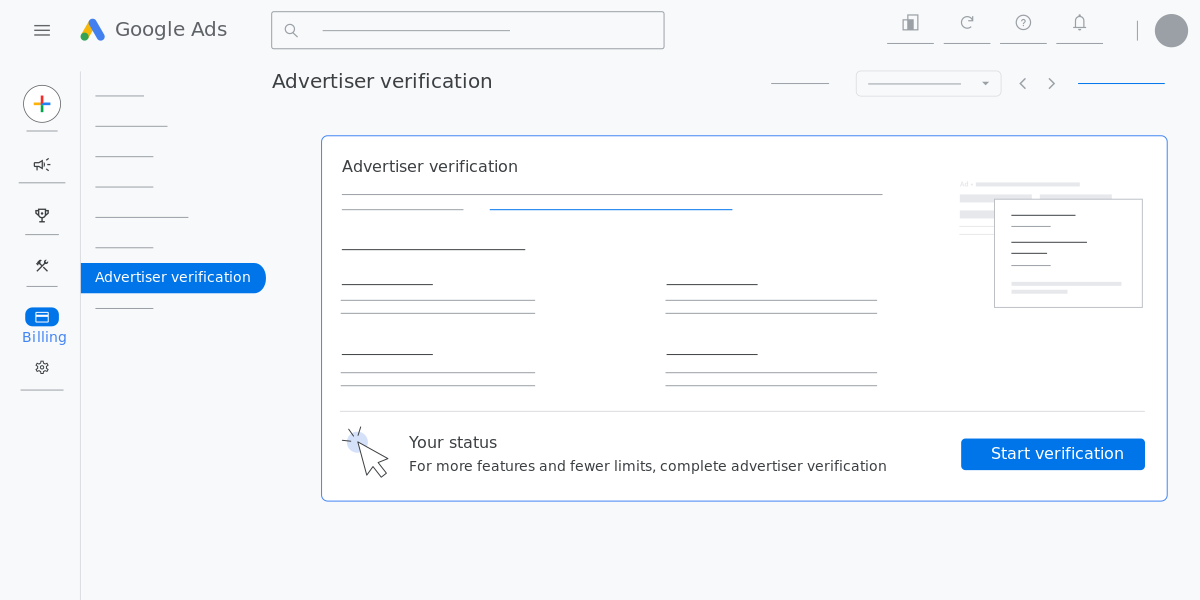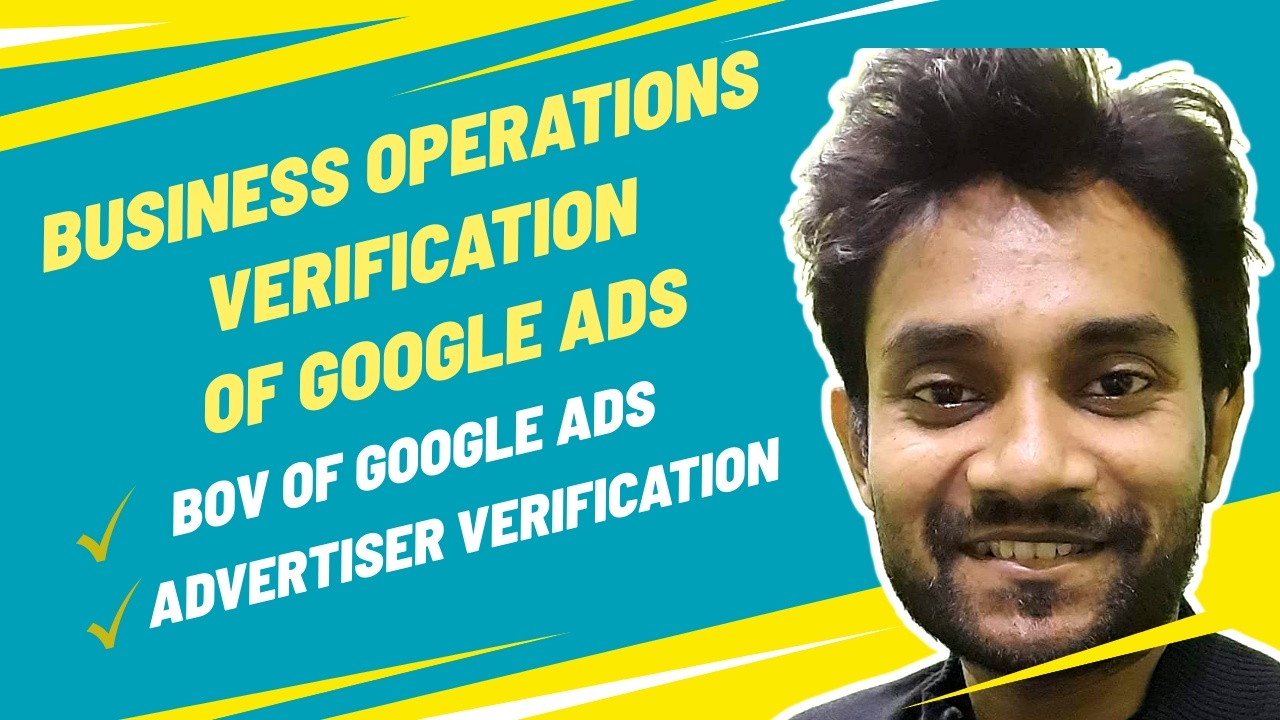This notification from Google Ads serves to inform advertisers that they must complete a business operations verification process within 30 days of receiving the first notification. The purpose of this verification is to ensure a safe and trustworthy advertising environment across Google’s platforms. Through this process, Google aims to gain a deeper understanding of the advertiser’s business, including the products and services offered, and any relationships with other businesses or entities.
Purpose of Verification:
- Business Operations Verification: Google requires advertisers to undergo this verification to confirm that their business practices align with Google’s advertising policies. The information collected during this process helps Google ensure that ads being shown to users are from legitimate and trustworthy sources.
- Documentation Requirements: As part of the verification process, advertisers may need to submit documentation. This documentation could include business registration, licenses, or proof of relationships with other businesses. Advertisers are advised to redact or hide any sensitive information before submission. Once the review is complete, any personal identifying information in the documents will not be stored, as per Google’s data retention policies.

Form Sections:
Part 1 – About the Advertiser:
- Google Ads Account Information: The advertiser is required to provide details about their Google Ads account, including the customer ID and the associated website. If the information is not pre-filled in the form, the advertiser must manually enter it.
- Website Usage: Advertisers must confirm whether the website listed in the form is still being used with their Google Ads account. This helps Google verify the connection between the website and the ads being run.
- Type of Ads Usage: Advertisers must select the option that best reflects how they use Google Ads. Options include running ads for their own business, running ads for an organization they work for, or running ads on behalf of another organization through an agency.
- Campaign Management: Advertisers are asked whether another business manages their ad campaigns. This is important for Google to understand who is responsible for the ads being created and managed under the account.
Part 2 – About You:
- Personal and Company Information: Advertisers are required to provide their full name, the name of their company, the company’s street address, city, postal code, and the email address used to sign in to Google Ads. This information helps Google verify the identity of the advertiser and establish a connection between the individual and the business they represent.
Part 3 – About the Advertiser’s Business Model and Partnerships:
- Business Type Description: Advertisers must provide a detailed description of their business type. This description should explain the nature of the business, such as whether it is a retail store, an insurance agency, or another type of business. The goal is to give Google a clear understanding of what the business does.
- Business Model Description: In this section, advertisers are asked to describe their business model in detail. This should include the type of business, the services or products offered, and the target audience. For example, if the business qualifies leads for home loans, this should be clearly stated, along with information about how those leads are generated and passed on to authorized banks.
- Target Audience: Advertisers must describe who their customers or target audience are. This includes both the direct users of the products or services and those who influence the purchasing decision. For example, a company selling children’s toys would list parents as the real customers, even though the toys are marketed to children.
- Interaction with Target Audience: Advertisers must explain how their company interacts with its target audience. This could include methods of communication, such as providing direct support through chat, email, or phone, or offering a platform that connects users with businesses listed on the website.
- Business Type Selection: Based on the information provided, advertisers must select the business type that best reflects their company. Options include:
- First Party: The company owns the products or services being advertised and is responsible for their quality and fulfillment.
- Online Sales Portal: The company promotes brands owned by other parties and facilitates sales through their website.
- Brand Reseller: The company is contracted to sell goods or services on behalf of another brand and uses their logos or brand materials.
- Marketing/Advertising Agency: The company promotes other brands through creative production or campaign management without being involved in the actual sale of goods or services.
- Other: If none of the above options apply, the advertiser can select “Other” and provide additional details.
- Required Relationships: Advertisers are asked whether any other relationships are necessary to provide the goods and services advertised. For example, if the company relies on a parent company, provider, or third-party relationships (excluding materials or shipping providers), this must be disclosed.
- Paid Marketing or Lead Generation Services: Advertisers must indicate if they provide paid marketing, advertising, or lead generation services, which would classify them as an advertising agency or affiliate.
Part 4 – Body Questions:
- Goods and Services Delivery: Advertisers are asked to describe how their target audience receives the goods or services promoted in their ads. This could include physical delivery, digital downloads, or other methods of fulfillment.
- Ad Content Creation: It must be stated who is responsible for creating the ad content, targeting, and keywords for the Google Ads account. This could be the advertiser’s own company or another business.
- Website Content Creation: Similarly, the advertiser must indicate who creates the content on their website. This helps Google determine the level of control the advertiser has over the content being promoted.
- Accountability for Non-Fulfillment: Advertisers must specify who would be held responsible if the goods or services advertised are not fulfilled. This is important for determining liability in case of disputes.
- Account Access: It must be stated if any other parties sign in to the Google Ads account. This helps Google track who has access to the account and ensure that only authorized individuals are involved.
- Branding Relationships: Advertisers are asked whether any other relationships are necessary to provide the branding used in ads or shown on the website. This includes franchising rights, authorized dealer relationships, or the use of logos and product names.
- Payment Responsibility: Advertisers must indicate who pays for the Google Ads account. This helps Google understand the financial relationships behind the account.
- Licensing Requirements: Advertisers are asked whether their company is required to hold any licenses or certifications to provide the products or services advertised. If another business holds the required licenses, this must also be disclosed.
- Customer Data Protection: Advertisers must explain how they protect their customers’ personal information. A link to the company’s privacy policy should be provided to demonstrate compliance with data protection regulations.
- Additional Documentation: Advertisers are encouraged to attach any additional documents that support the claims made in the form. This could include business registration, licensing, certifications, or proof of relationships with other businesses.
Part 5 – Closing Questions:
- Additional Comments: Advertisers have the opportunity to provide any additional comments or information that may be important for the verification process.
Finally, advertisers are reminded to review their answers before submitting the form, as the information provided will be used to verify their Google Ads account and is governed by Google’s privacy policy. Personal identifying information included in the submitted documents will be reviewed as part of the verification process but will not be stored once the review is complete, in accordance with Google’s data retention policies.
Reference blog – https://www.gomahamaya.com/business-operations-verification-google-ads/
For paid support whatsapp us – +917858910056

